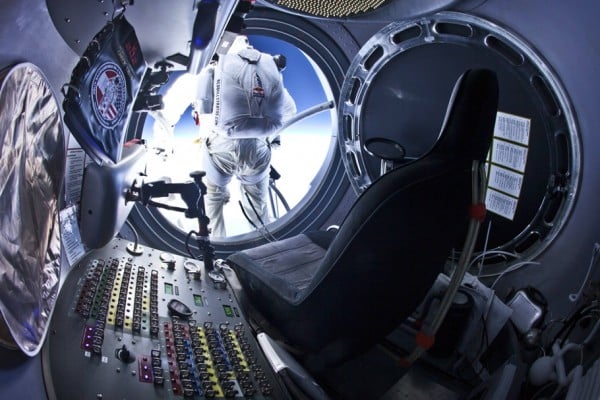Austrian Felix Baumgartner yesterday catapulted himself into the record books
yesterday by jumping from a balloon at an altitude of 39 kilometers. He also instantly became the #1 most frequently searched term on Google, so you’ve probably heard of him already.
The numbers are quite dazzling. Jump altitude was 38.900 meters, and he was in freefall (without a parachute deployed) for 36.429 of those. He reached a maximum speed of 1342.8 kilometers per hour freefalling towards our planet which meant he reached Mach 1.24 — solidly breaking the speed of sound. He is the first human to break the speed of sound by only using earth’s gravity, and there was some concern beforehand of the effects breaking the sound barrier would have on his body and suit.
He had made 2 earlier jumps from high altitude building up to this one, with the ultimate target being the record for highest jump, held for over 50 years by the American Joe Kittinger, now 84 years old and an adviser to this mission. Kittinger was also the person to communicate over the radio with Baumgartner for this mission, and probably the only person in the room who had a pretty good idea of what Felix was feeling up there. Several others died in the 60s trying to break Kittinger’s record, so this was a dangerous undertaking by any standard.
Red Bull is well known for sponsoring extreme projects, it’s part of their brand image. However this «Stratos» mission was a bit different, and a huge project even for a company like Red Bull. Really this was a science project, not just a daredevil carrying a brand flag. Felix was carrying a large array of scientific equipment, data-logging every millisecond of his mission in detail to be analyzed afterwards. The things learned during this mission will likely be used to make space travel safer in the future, giving them a way to bail out at altitudes never considered as possible before.
Felix and the small cabin from which he jumped were also loaded with high-definition cameras, footage from them will be used in an upcoming BBC documentary which is expected to come out in a month’s time.
Some of the cameras also streamed down to earth during the mission, allowing us to follow the mission in realtime online or on several TV channels who were covering the event. In fact, over 8 million people were watching the Youtube live stream when Felix jumped. Another record. The previous record was held by the London Olympics ceremony at half a million viewers. That this mission attracted 16 times more viewers says something about the magnitude of it. Especially when you consider that it was only announced a few hours beforehand due to uncertainty over weather conditions. An earlier attempt last Tuesday had to be scrapped because of high winds.
This record jump made people of my generation understand perhaps what our parents felt like when they were watching footage of space pioneers, and the moon landing. Of course we are lucky to have this technology where we can see the events unfolding before our eyes in high quality instead of simply reading about it in the paper afterwards.
The jump itself was quite eventful. The danger of doing something for the first time is that you can’t predict exactly what is going to happen. As Felix stood on the small step in front of the cabin, he said a few words before concluding «I’m coming home now» and stepped off into nothingness.
At this altitude, the air is so thin that you are close to a vacuum. Without his pressure suit and oxygen supply, Felix would die within seconds. And because there is almost no air to offer any resistance whilst falling, it is impossible to control the fall until you get to lower altitude where the air gets thicker again. This caused Felix to spin violently, literally tumbling his way down to earth for a good while before he gained control. He was at risk of severe disorientation and even losing consciousness due to the G-forces acting on his body during the spin. He also had a problem where the vizor of his helmet became fogged up due to a failed heating element, making it difficult for him to see his altitude and know when to pull his parachute. Just to emphasize that «stunts» like these are not routine and they very well can end up going wrong.
When he finally touched down safely and sank onto his knees in emotional celebration somewhere in desolate New Mexico, everybody watching felt they had witnessed something truly remarkable. Not just the records, but the sheer level of courage and persistence to pull off this feat were astounding. And it was a beautiful example of teamwork and friendship as well, with Joe Kittinger guiding his Austrian friend towards breaking his own records and keeping him safe.
In the end Felix Baumgartner broke world records for highest manned balloon flight, highest jumping altitude and highest speed during descent. The records will have to be officially confirmed, but initial data from the sensors he was carrying is pretty conclusive.
But even if he had not broken a single record, the millions of people who watched him live, and the many more who will see his name in the news today, would still stand in awe of this man who decided to put his life on the line in the name of science and personal achievement. At age 43, there is probably nothing he can do to ever top this. He’s more likely to retire and assist other adventurers, something he hinted at during the press conference afterwards.
But that’s all right, there is nothing wrong with simply being a living legend.
![]()
![]()
![]()
![]()
![]()











